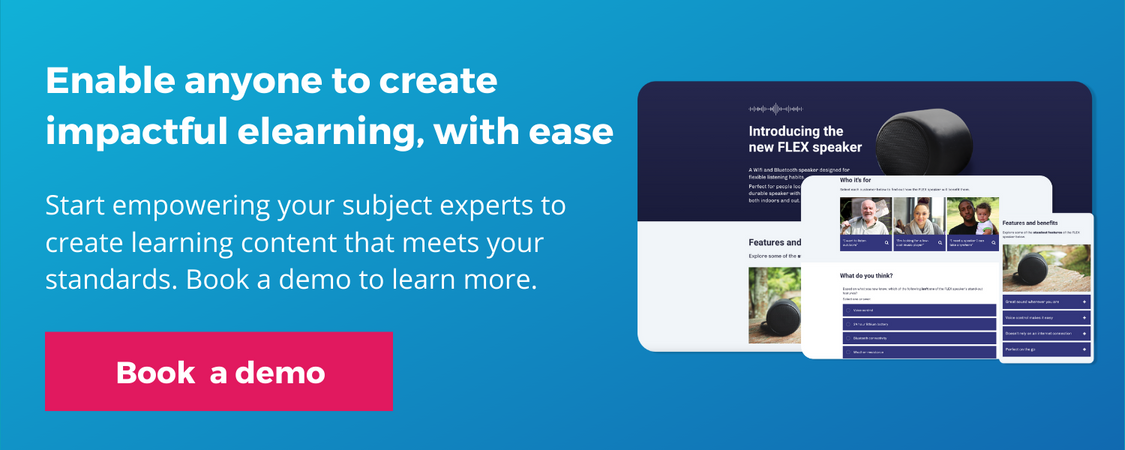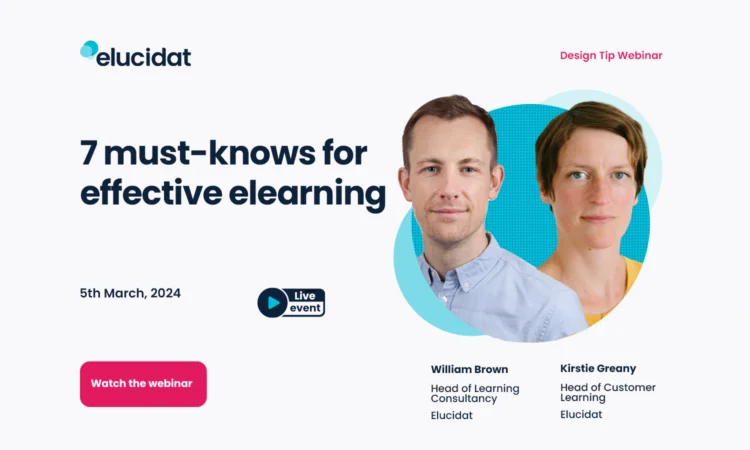How customers are unleashing the power of SMEs to create elearning (with videos)
5 minute read
50% of L&D teams are looking to bring in in-house subject experts to create content, in order to help meet demand. But how are L&D teams doing this whilst maintaining the quality of your learning offering, and motivating those subject experts to get involved? Read on for insider tips from L&D leaders at Aviva, nCino, Coca-Cola and D&G on how to set up successful collaborative content creation models.

Subject matter expert created content is the new way…
Collaborative Content Creation is about unlocking expertise from any employee within your organization to create effective learning.
Opening up authoring to novice authors expands capacity and increases efficiencies. It also helps cover those specialist subject areas unique to your organization.
Organizations that focus on collaborative authoring by adopting this workflow have seen exceptional benefits, including;
- Cutting learning costs
- Filling skills gaps
- Meeting learning demand
- Faster turnaround
- Delivering impactful learning
“I think the role of L&D is to really think through how to create and craft the optimal learning experience in partnership with people that are in the business that really know the subject material.”
– Jon Thompson, Director of Learning Experience & Innovation at The Coca-Cola Company
But it must be done with thought, care, tools and templates to ensure quality standards are upheld.
4 customer strategies for bringing SMEs onboard
The power of using templates – nCino
Instructional designer, Olivia Cunningham at nCino, sees using templates as vital to an effective SME production model.
“I could create templates, that aligned with the nCino brand and what our other courses look like, but also that incorporated instructional design best practices”
– Olivia Cunningham, Instructional Designer, nCino
By utilizing these templates, SMEs and novice authors can create impactful learning experiences with minimal assistance from the L&D team.
Listen to the full interview with Olivia from nCino here.
Adopting a center of expertise – Aviva
David Hepworth, Learning & Talent – Design and Technology Lead, adopts a ‘hub and spoke’ model at Aviva. This model empowers anyone from across the organization to create learning and share content to ensure L&D is not a blocker to meeting training needs.
“We’ve essentially created a hub and spoke model in the organization. I have about 300+ content creators globally.”
– David Hepworth, Learning & Talent – Design and Technology Lead at Aviva
L&D professionals sit at the center of the ‘wheel’ acting as the hub. They establish and maintain standards, while also motivating and enabling a group of employees to implement them. As coaches, consultants, evaluators, and attentive listeners, they provide support to achieve these goals. Ensuring Subject Matter Experts (SMEs) feel supported and encouraged is vital to making this a smooth running process.
They also provide some basic, but quick ‘training’ on what it means to create effective elearning, and only give subject experts a ‘license’ to create, once they’ve done that.
Listen to the full Learning at Large podcast episode with David from Aviva here.
Find your champions – Domestic & General
Jonathan Holmes and the D&G team have implemented a smart partnership model for digital learning production. Rather than seek any subject expert in the organization to take on a learning project, they first focused on finding their SME champions. These are the subject experts who are motivated and have some background in training. Concentrate your efforts on working with the ‘low-hanging fruit’ and establish a process of collaborating together. Finding your champions will enable you to gain traction and allow you to branch out wider into the business to bring in other experts from there.
“One of the ideas was to essentially build a community of people from all parts of the business that we’re able to either create or co-create solutions with us and effectively start to remove ourselves from being a blocker.”
– Jonathan Holmes, Digital Learning and Strategy Manager, Domestic & General
This model allows the D&G team to produce more projects in a shorter amount of time. Increasing efficiency enables their team to focus on more strategic initiatives, such as developing a new in-house learning localization process to support the global business. With this new approach, the team is no longer struggling to keep up with demand and is able to make better use of their skills and resources.
Watch the full webinar to find out more about this partnership model.
Find skill owners – Coca-Cola
Defining a clear taxonomy of skills and competencies is vital for the Coca-Cola team who has implemented an integrated capability model. Choosing content and capability owners, in each part of the business, they then work with them to help define the skills and competencies that are particularly important and relevant to a department.
“We are using the skills taxonomy as our organizing principle across the business. There are now content and capability owners in each part of the business.”
– Jon Thompson, Director of Learning Experience & Innovation at The Coca-Cola Company
Once this is achieved, they then look at how different departments might take ownership of developing key content for that skill. This means that the creation of content does not just land in the hands of the L&D team but is instead shared out, smartly. For example, corporate writing skills can be owned by Marketing.
Watch the full webinar to find out how to quit playing catch up with the learning backlog.
Summary
Collaborative Content Creation allows you to open up learning production, so the pressure doesn’t just fall into the laps of your team. But instead, encourages SMEs and other people within the wider organization to collaborate and create impactful elearning content. Customers who are bringing SMEs into the fold are finding they are able to create quality elearning faster, meet skills gaps that would be otherwise tricky to address and find the time to work on more strategic L&D projects themselves.
To help you ensure you tackle the learning content backlog, try:
- Adopting a center of expertise, like Aviva
- Take advantage of guided templates, like nCino
- Finding your champions, like D&G
- Developing a skills taxonomy, like Coca-Cola
Whichever strategy you decide to focus on, putting the right people at the center of your learning content creation is vital.
If you want to find out how Elucidat is set up to support novice authors, like subject experts, take a look at the powerful workflow, Guided Authoring.




